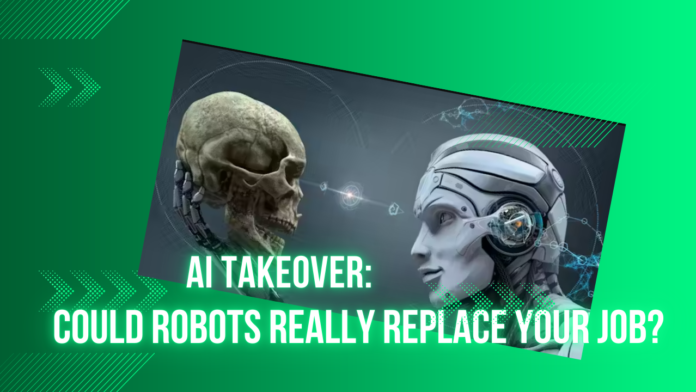The digital era has brought forth remarkable advancements in technology, with Artificial Intelligence (AI) at the forefront. As AI continues to evolve, a pressing question emerges: Could robots and intelligent systems really replace your job?
Table of Contents
The Rise of Artificial Intelligence
AI has progressed from a futuristic concept to a present-day reality. From machine learning algorithms to neural networks, AI technologies are now integral to various industries. This rise has sparked both excitement and concern about the future of work.
Understanding the AI Revolution
AI refers to the simulation of human intelligence processes by machines, particularly computer systems. These processes include learning, reasoning, and self-correction. As AI systems become more sophisticated, they can perform tasks that were once thought to be exclusive to humans.
Jobs at Risk of Automation
Manufacturing and Assembly Line Jobs
The manufacturing sector has long been a target for automation. Robots can perform repetitive tasks with precision and efficiency, reducing the need for human labor. This trend is likely to continue, potentially displacing many assembly line workers.
Administrative and Clerical Positions
AI can handle data entry, scheduling, and other administrative tasks more quickly and accurately than humans. Virtual assistants and chatbots are already replacing some clerical roles, streamlining operations and cutting costs.
Retail and Customer Service Roles
Self-checkout kiosks, automated inventory management systems, and AI-powered customer service chatbots are becoming commonplace in retail. These technologies reduce the need for human staff, transforming the landscape of customer service.
The Benefits of AI in the Workforce
Increased Efficiency and Productivity
AI can perform tasks faster and more accurately than humans, leading to significant productivity gains. Businesses can operate more efficiently, delivering products and services at a higher quality and lower cost.
Cost Savings for Businesses
By automating routine tasks, companies can reduce labor costs and minimize errors. This translates to substantial savings, which can be reinvested in innovation and growth.
Enhanced Precision and Accuracy
AI systems excel at tasks requiring precision and consistency. From manufacturing to data analysis, AI minimizes the risk of human error, ensuring high standards of quality and accuracy.
The Challenges of AI Integration
Job Displacement and Economic Impact
While AI offers numerous benefits, it also poses challenges, particularly job displacement. As machines take over certain roles, workers may find themselves unemployed or underemployed, leading to economic instability.
Skills Gap and the Need for Retraining
The shift towards an AI-driven economy demands a workforce with new skills. Retraining programs and education initiatives are crucial to help workers adapt to changing job requirements and stay competitive in the job market.
Ethical and Security Concerns
The integration of AI raises ethical questions about privacy, surveillance, and decision-making. Ensuring that AI systems are transparent, fair, and secure is essential to prevent misuse and protect individual rights.
Jobs Less Likely to Be Replaced by AI
Creative Professions
Roles that require creativity, such as artists, writers, and designers, are less likely to be automated. AI can assist with creative tasks, but human ingenuity and emotional expression remain irreplaceable.
Healthcare and Human Services
Professions involving personal interaction and empathy, like healthcare providers and social workers, are also less susceptible to automation. AI can support these roles, but human judgment and compassion are critical.
Skilled Trades and Technical Roles
Jobs that require manual dexterity and technical expertise, such as electricians, plumbers, and mechanics, are challenging to automate. These roles involve complex problem-solving and hands-on work that AI cannot easily replicate.
Preparing for an AI-Driven Future
Embracing Lifelong Learning
Continuous learning is key to staying relevant in the AI era. Pursuing new skills, certifications, and educational opportunities will help workers adapt to technological changes and remain employable.
Developing Soft Skills
Skills like critical thinking, creativity, communication, and emotional intelligence are becoming increasingly valuable. These soft skills complement technical abilities and are essential for thriving in a collaborative, AI-augmented workplace.
Leveraging Human-AI Collaboration
Rather than viewing AI as a threat, workers can embrace it as a tool for enhancing their capabilities. Collaborative systems where humans and AI work together can lead to better outcomes and create new job opportunities.
The Role of Policy and Regulation
Ensuring Fair Employment Practices
Governments and organizations must ensure that the integration of AI does not lead to unfair labor practices. Policies should promote equitable treatment, fair wages, and job security for workers affected by automation.
Supporting Workers Through Transition
Support systems, such as unemployment benefits, retraining programs, and career counseling, are vital for helping displaced workers transition to new roles. Investing in these initiatives can mitigate the negative impact of AI on employment.
Promoting Responsible AI Development
Regulations should encourage the development of ethical AI systems. This includes setting standards for data privacy, security, and transparency to build public trust and ensure that AI benefits society as a whole.
Success Stories of AI and Human Collaboration
Case Studies from Various Industries
Numerous industries have successfully integrated AI to enhance human work. For instance, in healthcare, AI assists doctors with diagnostics and treatment planning, improving patient outcomes. In manufacturing, AI-powered robots work alongside humans to increase efficiency and safety.
Lessons Learned from Early Adopters
Companies that have embraced AI highlight the importance of a strategic approach. Successful integration involves investing in employee training, fostering a culture of innovation, and prioritizing ethical considerations.
Conclusion
Embracing Change and Innovation
The rise of AI presents both challenges and opportunities. By embracing change and fostering a culture of innovation, we can harness the benefits of AI while addressing its potential drawbacks.
Final Thoughts
While AI may replace certain jobs, it also has the potential to create new ones and enhance existing roles. By preparing for an AI-driven future through education, skill development, and collaboration, we can ensure a prosperous and inclusive workforce.
FAQs
How soon will AI replace jobs?
The timeline for AI replacing jobs varies by industry and region. Some sectors are already seeing significant automation, while others may take decades to fully integrate AI. Continuous advancements in technology will likely accelerate this process.
What jobs are most at risk of being automated?
Jobs that involve repetitive tasks and routine data processing, such as manufacturing, clerical work, and certain retail positions, are most at risk. However, roles requiring creativity, empathy, and complex problem-solving are less likely to be automated.
Can AI create new job opportunities?
Yes, AI can create new job opportunities in fields such as AI development, data analysis, and cybersecurity. Additionally, AI can enhance existing roles, allowing workers to focus on more strategic and value-added tasks.
How can I future-proof my career?
To future-proof your career, focus on continuous learning and skill development. Embrace emerging technologies, cultivate soft skills, and seek opportunities for professional growth. Staying adaptable and open to change is crucial.

